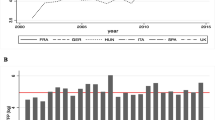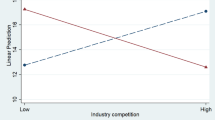Abstract
The paper analyzes the question whether blue-chip stock indices provide a larger degree of internationalization than mid-cap stock indices. Specific focus lies on internationalization of indices in France, Germany, and the UK. Additionally, we analyze whether the degree of internationalization differs between industries. The dataset covers the CAC40, the DAX30 and the 30 largest firms in the FTSE100 as blue-chip indices and the CAC Next 20 and CAC Mid 60, the MDAX and TecDAX, and the remaining 70 companies in the FTSE100 as mid-cap indices. The comparison of blue-chip and mid-cap indices is based on three indicators of internationalization: percentages of employees based outside the firms’ home country, percentages of foreign sales, and percentages of foreign corporate tax payments. Blue-chip and mid-cap indices exhibit high levels of internationalization. Internationalization is stronger in German and UK blue-chip indices than in these countries’ mid-cap indices, whereas internationalization in French mid-cap and blue-chip indices is similar. Blue-chip and mid-cap firms in the energy/materials/utilities and industrials sectors exhibit similar levels of internationalization, whereas blue-chip firms in the consumer and health sectors exhibit higher levels than corresponding mid-cap firms. The research question and results are of particular importance for retail and institutional investors, because investing in indices typically represents a low cost alternative to individual stock picking. The question whether stock index characteristics, such as market capitalization and industry, influence the degree of international diversification within the index is largely unanswered in the literature. The paper addresses this question.
Similar content being viewed by others
Notes
See e.g. https://www.msci.com/gics for further information.
Ietto-Gillies (2010) suggests a third dimension: geographic extensity, which reflects the number of countries a firm is active in. We do not use this dimension due to lack of data.
References
Aggarwal, R., Berrill, J., Hutson, E., & Kearney, C. (2011). What is a multinational corporation? Classifying the degree of firm-level multinationality. International Business Review, 20(5), 557–577.
Altomonte, C., Aquilante, T., Békés, G., Ottaviano, G. (2014). Internationalization and innovation of firms: evidence and policy, CEP Special Reports, CEPSP32. Centre for Economic Performance.
Baele, L., & Inghelbrecht, K. (2009). Time-varying integration and international diversification strategies. Journal of Empirical Finance, 16(3), 368–387.
Bekaert, G., & Harvey, C. R. (1995). Time-varying world market integration. Journal of Finance, 50(2), 403–444.
Bekaert, G., & Harvey, C. R. (2000). Foreign speculators and emerging equity markets. Journal of Finance, 55(2), 565–613.
Bekaert, G., Harvey, C. R., & Ng, A. (2005). Market integration and contagion. Journal of Business, 78(1), 39–69.
Bekaert, G., Harvey, C. R., Lundblad, C., & Siegel, S. (2007). Global growth opportunities and market integration. Journal of Finance, 62(3), 1081–1137.
Bekaert, G., Hodrick, R., & Zhang, X. (2009). International stock return comovements. Journal of Finance, 64(6), 2591–2626.
Békés, G., & Muraközy, B. (2012). Internationalization modes of European firms, EFIGE working paper 52.
Berrill, J., & Kearney, C. (2010). Firm-level internationalisation and the home bias puzzle. Journal of Economics and Business, 62(4), 235–256.
Brooks, R., & Del Negro, M. (2004). The rise in comovement across national stock markets: market integration or IT bubble? Journal of Empirical Finance, 11(5), 659–680.
Chiou, P., & Lee, C. F. (2013). Do investors still benefit from culturally home-biased diversification? An empirical study of China, Hong Kong, and Taiwan. Review of Quantitative Finance and Accounting, 40(2), 341–381.
Christoffersen, P., Errunza, V., Jacobs, K., & Langlois, H. (2012). Is the potential for international diversification disappearing? A dynamic copula approach. The Review of Financial Studies, 25(12), 3711–3751.
Curci, R., Mackoy, R., & Yagi, N. (2013). Stages and paths of firm internationalization: testing the value chain internationalization framework. Journal of Comparative International Management, 16(1), 3–22.
DeSantis, G., & Gerard, B. (1997). International asset pricing and portfolio diversification with time-varying risk. Journal of Finance, 52(5), 1881–1912.
Dörrenbächer, C. (2000). Measuring corporate internationalisation a review of measurement concepts and their use. Discussion Paper FS I 00–101 Wissenschaftszentrum Berlin für Sozialforschung.
Eiling, E., & Gerard, B. (2015). Emerging equity market comovements: trends and macro-economic fundamentals. Review of Finance, 19(4), 1543–1585.
Erb, C., Harvey, C., & Viskanta, T. (1994). Forecasting international equity correlations. Financial Analysts Journal, 50(6), 32–45.
Errunza, V. (1977). Gains from portfolio diversification into less developed countries’ securities. Journal of International Business Studies, 8(2), 83–99.
Errunza, V., Hogan, K., Kini, O., & Padmanabhan, P. (1994). Conditional heteroskedasticity and global stock return distribution. Financial Review, 29(3), 293–317.
Errunza, V., Hogan, K., & Hung, M.-W. (1999). Can the gains from international diversification be achieved without trading abroad? Journal of Finance, 54(6), 2075–2107.
Fillis, I. (2001). Small firm internationalisation: an investigative survey and future research directions. Management Decision, 39(9), 767–783.
Goetzmann, W., Li, L., & Rouwenhorst, G. (2005). Long term global market correlations. Journal of Business, 78(1), 1–38.
Grubel, H. G. (1968). Internationally diversified portfolios: welfare gains and capital flows. American Economic Review, 58(5), 1299–1314.
Hassel, A., Höpner, M., Kurdelbusch, A., Rehder, B., & Zugehör, B. (2003). Two Dimnsions of the internationalization of firms. Journal of Management Studies, 40(3), 705–723.
Hennart, J. F. (2013). The accidental internationalists: a theory of born global. Entrepreneurship: Theory and Practice, 38(1), 117–135.
Hitt, M. A., Hoskisson, R. E., & Kim, H. (1997). International diversification: effects on innovation and firm performance in product-diversified firms. The Academy of Management Journal, 40(4), 767–798.
Horst, T. (1972). Firm and industry determinants of the decision to invest abroad: an empirical study. The Review of Economics and Statistics, 54(3), 258–266.
Ietto-Gillies, G. (1998). Different conceptual frameworks in the assessment of the degree of internationalisation: empirical analysis of various indices for the top 100 TNCs. http://www.bus.lsbu.ac.uk/cibs/sites/bus.lsbu.ac.uk.bus.cibs/files/1998aAAJ%20Indices%20TNCJ.pdf. Accessed 7 October 2016.
Ietto-Gillies, G. (2010). Conceptual issues behind the assessment of the degree of internationalization.
Levy, H., & Sarnat, M. (1970). International diversification of investment portfolios. American Economic Review, 60(4), 668–675.
Longin, F., & Solnik, B. (1995). Is the correlation in international equity returns constant: 1960-1990? Journal of International Money and Finance, 14(1), 3–26.
Mayer, T., & Ottaviano, G. (2007). The happy few: the internationanlisation of European firms. Brussels: Bruegel.
Oehler, A., Wendt, S., Horn, M. (2015). Are investors really home biased when investing at home? Paper presented at Eastern Finance Association 2015 Annual Meeting, April 8–11, New Orleans/LA.
Phengpis, C., & Swanson, P. (2011). Optimization, cointegration and diversification gains from international portfolios: an out-of-sample analysis. Review of Quantitative Finance and Accounting, 36(2), 269–286.
Pukthuanthong, K., & Roll, R. (2009). Global market integration: an alternative measure and its application. Journal of Financial Economics, 94(2), 214–232.
Ramaswamy, K., Kroeck, K. G., & Renforth, W. (1996). Measuring the degree of internationalization of a firm: a comment. Journal of International Business Studies, 27(1), 167–177.
Riahi-Belkaoui, A. (1999). The degree of internationalization and the value of the firm: theory and evidence. International Accounting, Auditing & Taxation, 8(1), 189–196.
Sanders, W. M. G., & Carpenter, M. (1998). Internationalization and firm governance: the roles of CEO compensation, top team composition, and board structure. Academy of Management Journal, 41(2), 158–178.
Solnik, B. (1974). The international pricing of risk: an empirical investigation of the world capital market structure. Journal of Finance, 29(2), 365–378.
Stulz, R., & Williamson, R. (2003). Culture, openness, and finance. Journal of Financial Economics, 70(3), 313–349.
Sullivan, D. (1994). Measuring the degree of internationalization of firm. Journal of International Business Studies, 25(2), 325–342.
Acknowledgements
We would like to thank Sergey Barabanov, University of St. Thomas, Minneapolis, Thomas Walker, Concordia University, Montreal, Andreas Höfer, participants of the 2015 Annual Meeting of the Academy of Financial Services, and an anonymous referee for helpful comments and suggestions. We further thank the editor and seminar participants at Bamberg University in Bamberg, Germany and Concordia University in Montreal, Canada. All remaining errors are our own.
Author information
Authors and Affiliations
Corresponding author
Rights and permissions
About this article
Cite this article
Oehler, A., Wendt, S. & Horn, M. Internationalization of Blue-Chip versus Mid-Cap Stock Indices: an Empirical Analysis for France, Germany, and the UK. Atl Econ J 44, 501–518 (2016). https://doi.org/10.1007/s11293-016-9518-2
Published:
Issue Date:
DOI: https://doi.org/10.1007/s11293-016-9518-2
Keywords
- International diversification
- Internationalization
- Blue-chip firms
- Mid-cap firms
- Stock market index
- Retail investors




